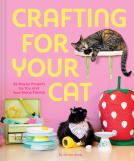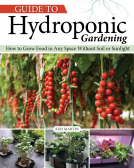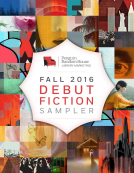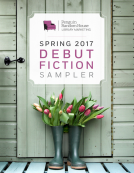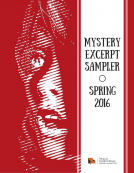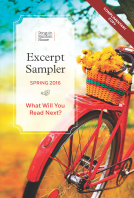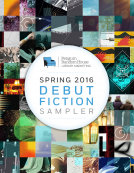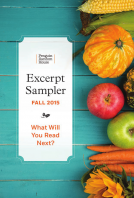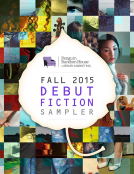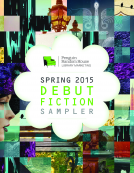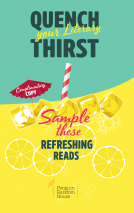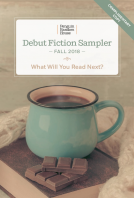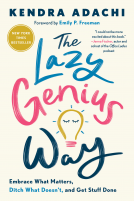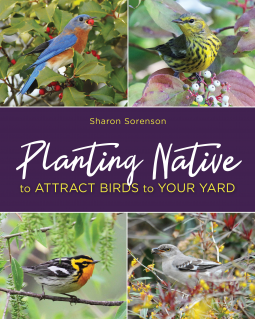
Planting Native to Attract Birds to Your Yard
by Sharon Sorenson
This title was previously available on NetGalley and is now archived.
Send NetGalley books directly to your Kindle or Kindle app
1
To read on a Kindle or Kindle app, please add kindle@netgalley.com as an approved email address to receive files in your Amazon account. Click here for step-by-step instructions.
2
Also find your Kindle email address within your Amazon account, and enter it here.
Pub Date Aug 01 2018 | Archive Date Aug 10 2018
Rowman & Littlefield | Stackpole Books
Talking about this book? Use #PlantingNativeToAttractBirdsToYourYard #NetGalley. More hashtag tips!
Description
In 2007, Douglas Tallamy published the groundbreaking book, Bringing Nature Home, on going native to protect wildlife. Since then Cornell Laboratory of Ornithology, the National Wildlife Federation, and National Audubon have all endorsed and encouraged gardening with native plants.
Planting Native to Attract Birds to Your Yard is the first book to cover planting native to specifically attract birds. The book recommends plants for all types of backyards, no matter how large or small—from large plots to container gardens. Sorenson gives state-specific recommendations for 31 Eastern U.S. states—including and east of Minnesota, Iowa, Missouri, Arkansas, and Louisiana to the East Coast, and from the Canadian border to the Gulf Coast—for native plants that support birds during the four seasons. The book covers the full gamut of native plants—nearly 200 species of trees, shrubs, vines, grasses, and perennials—and gives details on why specific plants are bird friendly and how to choose plants that work successfully in attractive home landscapes. It also includes dramatic color photos of nearly 70 bird species.
Birders, gardeners, and landscapers—all who love birds and beautiful gardens—will find this book a must.
Available Editions
| EDITION | Other Format |
| ISBN | 9780811737647 |
| PRICE | $24.95 (USD) |
Links
Average rating from 12 members
Featured Reviews
Comprehensive guide to attracting birds to your yard using native plants. Part scientific research, part biology, and part folksy wisdom. Surprisingly humorous photos and captions.
 Alexis A, Reviewer
Alexis A, Reviewer
The author makes a compelling argument for planting native plants in your garden, while addressing common concerns on the topic. The most compelling argument comes from the call to support the birds you take for granted around you, but even bird haters might be convinced by the explanation of biodiversity, and natural preservation against invasive species given to support native plants. I learned a lot about both plants and birds, and readjusted my thinking about the ease of a bird's life. Much of their time is devoted to survival and reproduction, and they truly aren't as carefree as they seem to be sitting on their branches. This book details their use of energy, what attracts them to a site, and how to make your own tallies to see how bird friendly your setup truly is. If you want more birds in your yard or different ones, this details how to think like the birds, and set up what will attract them. It is well thought out and easy to follow, plus I discovered that the birds in my yard likely ate one of my favourite plants due to it having catkins, something the plant store couldn't figure out when it happened. If you want to better help your native birds, or just see new ones around, following this guide may teach you a new respect for birds, and appreciation for how native plants support the land around us.
 Candace P, Reviewer
Candace P, Reviewer
This book was really packed with great facts about planting natively and planning our your yard. I will be purchasing it as a reference book for my parents and I. It has location specific information about the best native plants in the US. I really learned a lot and feel like there is great lessons that everyone should learn in here.
🌿🐛🦋🐝🐞
 Catlin P, Reviewer
Catlin P, Reviewer
If you are interested in attracting birds to your yard, and you live in the eastern half of the US, this is a great reference. While it is quite comprehensive, it's still written simply enough for the beginner to comprehend. In fact, the author points out several important facts about gardening with native plants that I've not seen addressed in other similar books. The book is divided into chapters that focus on the "why" of using native plants, including the variety of nutritional needs for different birds, the shelter that native plants can provide, and the environmental costs of wild bird feeders. An entire chapter covers the concept of "native" plants, and educates us on the differences even within a species (for example, some hybrids of a native species may be sterile, not producing fruits or seeds. The last chapters of the book focus on things to consider when selecting native trees, shrubs, vines, perennials and annuals, including profiles of several species within each chapter. The book is also generously illustrated with photos of both birds and plants. I would highly recommend this reference to anyone who wants to start using native plants. It's not as easy as just going to the nursery and looking for "native" labels. My only criticism is that I wish there were a similar book for the Western half of the US!
🐦🐦🐦🐦🐦
PLANTING NATIVE TO ATTRACT BIRDS TO YOUR YARD is a truly beautiful book and the first to cover this intriguing topic. Included are ideas for all types of backyards, no matter the size, whether sweeping lawn or container garden. The author recommends plants that support birds all year in 31 Eastern U.S. states, including 76 types of trees, bushes, vines, shrubs, grasses, perennials, and annuals. Stunning color photos of 66 bird species are also featured, making this a must-read for birders, gardeners, and landscapers alike. 5/5
Thanks to Rowman & Littlefield and NetGalley for the review copy. Opinions are fully mine.
#PlantingNativeToAttractBirdsToYourYard #NetGalley
 Marzie K, Reviewer
Marzie K, Reviewer
Earlier this year I reviewed a thoughtful book The Birds at My Table by Darryl Jones. It asked hard questions about what we offer birds by feeding them at feeders. Sorenson asks equally hard questions about the environmental cost of producing seed feed for birds, in lieu of providing a native plant environment that seasonally provides a greater nutritional variety and greater benefits for birds and humans who enjoy them. Early on in the book, she asks you to think about packaged sunflower seeds, as any bird lover knows, a great favorite of wild birds. She points out the environmental costs of production, packaging, and shipping, but also asks the bird-loving reader to look deeper at the entire process from the start. Sunflower seeds are produced in vast monoculture fields. Readers of another of my recently reviewed books, Endangered and Disappearing Birds of the Midwest, should consider the fate of Prairie-Chickens and Meadowlarks when the prairies are planted with sunflowers. Are the seeds cultivated here grown in fields that have been sprayed with herbicides, fungicides, and pesticides? Do these chemicals affect the seeds produced, exposing the birds to these agents? Where does the field runoff go? Into a fresh water supply, affecting all the wildlife in the region? When it comes down to it, the tough question is: are our natural resources being damaged for artificially feeding birds? What would the alternative be? The best alternative is to enrich the native plant population, returning birds to a diet that better resembles nature. Sorenson gives you key insights into how to enrich your yard and make it a more natural haven for all birds, not just the ones that might have shown up at your feeder, who are often only a small fraction of birds actually in your yard.
It's important to note that this book is focused on the Eastern and Central US regions and doesn't contemplate plants native to the West or the Far North. I did find discussion of perennial plants and trees that still could thrive in the Seacoast area of New England, however. This book is a serious examination of native plants and trees benefitting birds and is not a quick read. For the serious birder, however, it is a goldmine. Sorenson will teach you how to map your yard, and then pick plants, trees, and vines that work well seasonally to support your local bird population. She also recommends water features that will provide a source of fresh water for your birds. For anyone who loves birds, this is a useful book. Even if you do not live in the targeted region, there are strategies to be learned here.
 Pam N, Reviewer
Pam N, Reviewer
Thank you for the opportunity to receive a copy of this book for review.
Having been a gardener and feeder of birds, especially hummingbirds, for decades, I was convinced there was little new information to learn about these two subjects. I was very wrong! This book is a gem. Especially helpful was the information about native plants, insects as bird nourishment, bird habitat, and the use of bird feeders in the garden setting. The book is filled with clear and attractive
photos of birds and plants. This reference book should be on the library shelf of every serious gardener.
 Charity H, Reviewer
Charity H, Reviewer
The photos in this book are BEAUTIFUL. But, if you enjoy bird watching having this book will be helpful because it gives you ideas on how to attract birds to your yard. I know there are many types of birds and locations. But, this book is helpful and no matter where you are or what birds you'd like to attract I think you'll find something useful or at least interesting inside.
 Educator 337568
Educator 337568
I really enjoyed reading this books as I live in California, and have a plethora of birds in my yard. I was also happy to see information on drought Native plants that are good for gardens and good for the environment. Highly recommended to anyone who wants to try to plant native and specifically attract birds.
 Kimberly P, Reviewer
Kimberly P, Reviewer
Here in the Northeastern part of the United States in April, we haven't planted our gardens yet. But we are cleaning up our and gardens and preparing them for planting. We are buying shrubs and trees and perennials too. If you are wondering what to plant, PLEASE think about birds before you do. Are you investing in plants that are native to your area? Birds need native plants to thrive and if you already know this, hooray!!! But if not, and you live in the Eastern part of the U.S., this book might be just what you need to help you choose plants for your yard!
The book I'm recommending is called Planting Native to Attract Birds to Your Yard by Sharon Sorenson. What I love about this book are several things: The photos of birds and native plants are gorgeous, the quotes by naturalists sprinkled throughout the text are inspiring, and the facts that are highlighted bring perspective, importance, and responsibility to us as property owners.
Another thing I like about this book is that in chapters 1-3, the author explains EVERYTHING--even down to a definition of what a native plant is (not a weed!) She doesn't simply say "birds need native plants for shelter, nests, and food", but explains how birds use the plants for shelter, nests, and food, and why it's so crucial that we have them in our yards.
Did you know that native plants are actually less work and less expensive to care for than non-native plants? They don't need fertilizer, and they rarely need watering, pruning, or deadheading either!
In Chapter 4, the author helps us to formulate a plan for our yard and garden spaces, by analyzing what is already in our yard and neighborhood. We make a list of assets and liabilities. She also includes a list of invasive plants named "The Disaster Dozen". She shares why they are such a problem, how to get rid of them, and what to replace them with.
She goes on to have ample suggestions for what to plant in any size space. Chapter 5 is dedicated to Native Trees with consideration of biodiversity, soil conditions, space, personal preference, and more! Chapter 6 is all about Native Shrubs and Vines and she has you choose one for each season. (I would've never thought of this!)
Chapter 7 is Native Perennials: Flowers and Grasses, and finally, Chapter 8 discusses Adding Water.
So, if you are a property owner, gardener, landscaper, or bird lover, I highly recommend that you order this book here or from your favorite bookseller!
